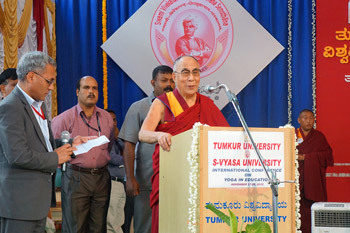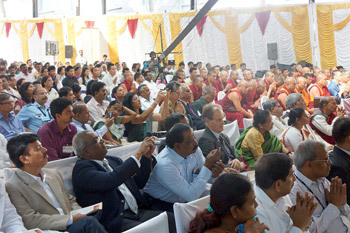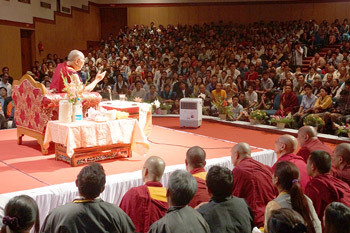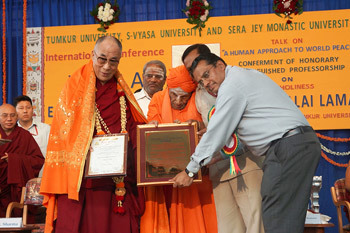Bangalore, Karnataka, India 27 November 2012 - This morning His Holiness the Dalai Lama drove about 70kms north-west of Bangalore to visit Tumkur University, where he was warmly welcomed on arrival by representatives of the university and monks and lamas of Sera-je Monastic University. Joining him on the dais were Dr Sree Sree Shivakumara Maha Swamiji of the Sree Siddaganga Mutt, Tumkur, who has attained the venerable age of 105; Prof HR Nagendra Vice-Chancellor of S-Vyasa University, a local Yoga University; Dr Apathukatha Shivathanu Pillai, India’s principal rocket scientist; Dr P Sadananda Maiya, a major benefactor of Tumkur University and Prof SC Sharma, the Tumkur University Vice-Chancellor.
Following a resonant invocation by the Sera-je monks, Prof Sharma gave an enthusiastic welcome address and a brief introduction to His Holiness the Dalai Lama. He then requested His Holiness to participate in an exchange of memorandums of understanding first between Tumkur University and Sera-je Monastic University and then between Tumkur University and S-VYAS University to mark the co-operation that is being established between them. His Holiness and Dr Sree Sree Shivakumara Maha Swamiji then lit a lamp to formally inaugurate proceedings. For its part, Sera-je offered a Tibetan style lamp to His Holiness and then offered images of the Buddha to the assembled dignitaries.
Tumkur University was pleased to confer on His Holiness an Honorary Distinguished Professorship, presenting him with a ceremonial shawl and framed certificate. He was then invited to inaugurate the International Conference on Yoga in Education.
He began his talk saying how happy he was to inaugurate this important conference, and went on to thank the University for the great honour of bestowing on him an honorary professorship, remarking jokingly,
“It’s a great honour, especially as I haven’t really done the required study and won’t have any time to do the required teaching!”
“Now, to begin with, I’d like to say a few words about India. Among the several great ancient civilizations, India is one that has given great thought to the nature of reality. Along with the concept of ahimsa or non-violence that has become part of its heritage, this is significant. Ahimsa finds expression, for example, in India’s remarkable and longstanding religious tolerance. This has seen homegrown faiths such as the Samkhya, Hindu traditions, Jainism, Buddhism and later Sikhism, and religions from abroad such as Zoroastrianism, Judaism, Christianity and Islam living harmoniously side by side.”
Meanwhile, in the world at large, in the twentieth century the destructive power of technology reach unthinkable levels with, quite apart from “conventional” warfare, the actual use of nuclear weapons with terrible results. His Holiness recalled visiting both Nagasaki and Hiroshima and meeting survivors who recounted their gruelling experiences. He suggested that if the violence and bloodshed of the twentieth century, in the course of which an estimated 200 million people met violent deaths, had led to a better world it might somehow have been justified, but that was not the case. Therefore, it is important to acknowledge that trying to solve our problems and disputes through violence is completely out of date. We must find a fresh approach and the realistic and humane alternative is to engage instead in dialogue.

|
His Holiness the Dalai Lama speaking at the inauguration of the International Conference on Yoga in Education at Timkur University in Bangalore, India, on November 27, 2012. Photo/Jeremy Russell/OHHDL
|
In the past people sought the destruction of their opponent, but today in our increasingly interdependent world, when for example our economies are intertwined, the destruction of an opponent would lead to our own destruction. Similarly, the damage we are doing the environment will ultimately only do us harm. We must find peaceful solutions. His Holiness mentioned a Mongolian astronaut who told him how he’d been so moved by the sight of our beautiful blue planet from space that he has dedicated himself ever since to protecting its ecology. This is the kind of change of heart we need.
“Sometimes dialogue is seen as a sign of weakness, while violence is regarded as a sign of strength, but this is quite wrong. Developing respect for the rights of others, their right to life and their way of life, is the basis of ahimsa.”
The demarcation between violence and non-violence is the motivation. If we cheat and exploit others with a smiling face and beguiling words, we are actually engaging in a form of violence. Our ultimate source of strength is warm-heartedness.
Going back to the question of religious harmony, His Holiness said that we have a variety of religious traditions because there are different people with different culture living in different places. Compassion, tolerance and self-discipline are taught by them all, and it is self-discipline that helps us resist negative action, it’s about personal restraint. He said that along with self-discipline we need contentment, because as wealth increases, greed seems to increase and with it a sense of competition. This gives rise to mistrust and suspicion, which leads to fear, frustration, anger and all too often violence. He said,
“Those who have little interest in spirituality shouldn’t think that human inner values don’t apply to you. The inner peace of an alert and calm mind are the source of real happiness and good health. Our human intelligence tells us which of our emotions are positive and helpful and which are damaging and to be restrained or avoided.”

|
Audience members listening to His Holiness the Dalai Lama speaking at the inauguration of the International Conference on Yoga in Education at Timkur University in Bangalore, India, on November 27, 2012. Photo/Jeremy Russell/OHHDL
|
His Holiness averred that India has the potential to combine the values of ancient traditions with modern education, which is why conferences such as this one focussing on Yoga in education has such a positive potential. He went on to offer his congratulations on the special relations being established between Tumkur University and Sera-je Monastic University. He said this fulfilled one of his long-standing wishes as a chela of Indian gurus. In the course of time, the guru has neglected aspects of his ancient thought, but the time has come to study ancient Indian philosophy once more. As reliable chelas of Indian gurus, Tibetans have kept ancient Indian knowledge alive. He observed that while Buddhist religious teaching is a matter for private individual interest, there are many aspects of Buddhist philosophy and science that are of universal appeal and can be of universal benefit.
To a question from the floor about how to train children in love and kindness, His Holiness replied,
“In our education system, we need to included lessons like those concerning physical hygiene that focus on mental and emotional hygiene, that teach how to develop a healthy mind. This is the core of what I call secular ethics and we are working to create a draft of a map of the mind and emotions to put it into effect.”
Following lunch with the Vice-Chancellor Dr Sharma and Dr Pillai, His Holiness drove back into Bangalore to meet Tibetans who are based in the city. He expressed his happiness at their being able to meet together even for only a short time. He told them that although Tibetans have been in exile for 53 years which is long in terms of an individual’s life, it is short in terms of a people’s struggle for freedom. He was happy to say that in exile Tibetans have been able to keep their traditions and culture and that the spirit of all Tibetans, those in Tibet as well as in exile remains remarkably strong.
He praised India for its democracy, rule of law and religious freedom and spoke of the importance of Tibetans keeping their honesty and integrity intact.
“If you are sincere you can be honest and transparent with others; if you are insincere you will easily become deceitful. Never think that being kind to others is an invitation to them to exploit you.”

|
His Holiness the Dalai Lama speaking to a gathering of Tibetans based in Bangalore, India, on November 27, 2012. Photo/Jeremy Russell/OHHDL
|
He pointed out that there is more to Dharma practice than reciting prayers or playing musical instruments. Tibetan Buddhism is most profound and the Tibetan written and spoken language is ideally suited to expressing that profundity. This is one of the reasons why it is important to use and extend the Tibetan language. Some schools in exile are now teaching modern subjects like science entirely in Tibetan and even employing traditional debate techniques to examine modern topics, which is a positive development.
His Holiness reviewed the steps that had led to his devolving his political responsibilities to the elected Tibetan leadership and ending the nearly 400 year old tradition of the Dalai Lamas wielding both political and spiritual authority.
“In the past when I was travelling abroad, I sometimes worried what would happen to the Tibetan cause if there were to be an accident and I were to die. Now I feel more relaxed and confident that the Tibetan cause can continue without me and that the elected leadership will ensure this. Although I’ve told them that should they need my help, I am ready to give it.”
Addressing students, he said they should understand that Buddhism involves transforming the mind and that they should be able to explain what it was about if fellow students asked. Essentially, he explained, Buddhism is about the view of dependent origination and the conduct of non-violence, helping others if you can, but at least avoiding doing them harm. He also counselled them to reach out to Chinese students who may be studying with them. China will change and these young students may be leaders themselves one day, so it’s worth taking the opportunity to explain the reality of Tibet to them.
Requested by local journalists to say a few words in English, His Holiness recalled first visiting Karnataka in 1956. Later, when he and many Tibetans came into exile, Prime Minister Nehru wrote to Indian Chief Ministers asking if any could offer help to Tibetans. Karnataka Chief Minister Nijalingappa was particularly imaginative and generous in providing land for settlements. As a result, 40,000 Tibetans are now settled here and, most important, the great monasteries preserving the pure Nalanda tradition have been re-established.
“The people and government of Karnataka have been especially helpful to us over the years and I would like to express my deep appreciation to them all. Thank you.”
















